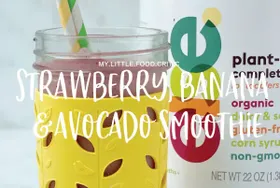Navigating Child Nutrition: Challenges and Solutions for a Healthier Future
Explore insights on child nutrition, the impact of food insecurity, and effective solutions to promote healthier eating habits in children
Updated August 5, 2024

Ensuring that a child has a balanced and healthy diet that is full of nutritious meals can be a challenge for parents. Every family situation is different, but a variety of factors can prevent children from eating nutritious foods. Let's delve into the complexities of child nutrition and the steps we can take to foster healthier eating habits for our children.
» Explore the delicious world of plant-based nutrition for a healthier start
Understanding the Barriers to Nutritious Eating in Childhood
Some families live in communities where access to fresh food markets and healthy meals is limited.
Instead, fast food establishments and convenience stores are the only local food sources. This means that many families have no access to fresh fruit and vegetable options. Other families live in areas of food shortages due to climate effects, civil unrest, or poverty which greatly affects child nutrition.
Also, some kids eat school meals in a cafeteria that lacks healthy eating options for school breakfast and lunch. In other cases, it is simply that a child has developed taste preferences for high-fat, sweetened, and salty foods due to introduction during the toddler years.
Whatever the reason, the fact remains—children worldwide are not consuming the proper nutrients and healthy food in their diets. A report by The United Nations Children’s Fund (UNICEF), State of the World’s Children 2019, shows some startling statistics on child nutrition:
- 1 in 3 children under the age of 5 are either undernourished or overweight, resulting in stunting of growth, muscle wasting, and obesity
- 1 in 2 children suffers from “hidden hunger,” deficiencies in vitamins and essential nutrients
- 1 in 5 children aged 5 to 19 are considered overweight (BMI >19)
» Support your child's natural immunity with nutrition
The Importance of a Healthy Diet for Growth and Development
According to the Centers for Disease Control and Prevention (CDC), calories from added sugars and fats contribute to 40% of the daily caloric intake for children aged 2 to 18. The primary sources of these calories come from soda, fruit drinks, desserts, pizza, and whole milk. Based on this, it is clear that improvements need to be made regarding global child nutrition.
A healthy diet is crucial for optimal growth and cognitive development in child nutrition, but, unfortunately, children are not consistently eating enough of the right kinds of foods. If the appropriate nutrients are lacking, various important milestones are affected. For example:
- Calcium absorption is important for maximum bone density, muscle mass increase, and brain maturation throughout childhood.
- Iron, in particular, is essential for brain function; research has shown reduced academic achievement in the presence of iron deficiency.
» Explore organic, plant-powered nutrition for healthy growth
WHO Recommendations for a Balanced Diet
The WHO recommends a balanced diet of grains or tubers (i.e. potatoes, yams), legumes, vegetables, fruits, and proteins.
Vegetables and fruits provide essential vitamins, minerals, fiber, plant protein, and antioxidants. These all lower the risk of obesity, heart disease, type II diabetes, and some forms of cancer. A diet with adequate protein is vital for both muscle and tissue building in a young child.
However, how much of each food group a child should eat varies by age, gender, and amount of physical activity. When too much or too little is consumed, the risk of health-related illness increases.
» Discover how to create a balanced diet for kids
A Pediatric Perspective
In clinical practice, pediatricians witness a variety of childhood eating habits. In the best scenario, some children seem to naturally be “healthy eaters,” enjoying any food put on the plate. Other kids prefer only fruits, therefore, missing the nutrients and health benefits that vegetables would provide. Then, there are children who will only eat a few foods from each food group.
» Understand food groups for kids
While some of these “selective eaters” have a diagnosed developmental disorder or autism, many do not.
Additionally, there seems to be a preference for “Kid Junk Food Trifecta:” chicken nuggets, macaroni and cheese, and pizza. The chicken nuggets are typically from a fast-food establishment; the macaroni is the “boxed” version, and, by pizza, it means only dough, sauce, and cheese.
Although there are many theories as to why children may refuse healthy foods, research has shown an association of food marketing with unhealthy food choices. Advertisers promote kid-friendly products, but these foods are often low in nutritional value. When seen often enough, children find the advertised food to be more appealing, choosing it over healthier options.
» Explore nutritious food choices for your baby
Efforts to Improve the Current Trends in Child Nutrition
Infant formula companies have developed nutritional beverages to address UNICEF's concerns about stunted growth during the early childhood years. In theory, by offering a supplement with vitamins, proteins, healthy fats, and carbohydrates, parents have another way to provide essential nutrients.
» Understand infant and toddler carbohydrate needs
Creative marketing has convinced many parents that these products are beneficial for child nutrition. However, when examining the ingredients, there are some concerns. The second or third ingredient is often sugar. While this added sugar may give the product an appealing taste, it can promote tooth decay and obesity. It also increases the likelihood of developing type II diabetes later in life.
Although it may not have been the developers' intention, the high sugar content of these beverages puts them in the category of a “sugary drink,” which the American Academy of Pediatrics discourages.
The CDC agrees, stating that no more than 10% or 200 calories of one’s total daily calories should come from sugar. The currently available nutritional beverages contain 12-18% sugar, much more than the recommended amount. Fortunately, there is a much better option for child nutrition.
» Explore our extensive guide to healthy foods and nutrition for toddlers
Else Organic Plant-Based Nutrition
Else stands out as a unique, complete supplemental nutrition. It contains the essential vitamins and nutrients that many children lack in their usual diets. Unlike competitor products, Else contains no milk or soy proteins, making it ideal for kids with such allergies. Those who follow a vegan diet will find this aspect appealing (some versions of the competitor product contain tuna oil).
There are some special situations where Else may be beneficial.
- Children with inflammatory bowel disease often eat less due to abdominal pain, and their bowel inflammation impairs nutrient absorption. Else could be a source of nutrients that are difficult for these children to get.
- Young cancer patients suffering from anorexia during chemotherapy treatments may also benefit from this product.
- In situations of food scarcity, such as during a natural disaster, Else could be a temporary, supplemental source of nutrition.
The WHO has set goals for child nutrition with the hope of meeting them by 2025. They seek to lower the rates of stunted growth under age 5, reduce childhood wasting to less than 5%, and stop the rise of childhood obesity. A healthier nutritional supplement such as Else may be just the product needed to help achieve these goals.
The content and advice provided in this article are for informational purposes only and are not a substitute for medical diagnosis, treatment, or advice for specific medical conditions. Always consult a pediatrician to understand your child's individual needs.











